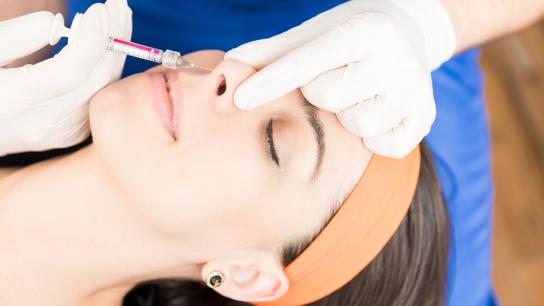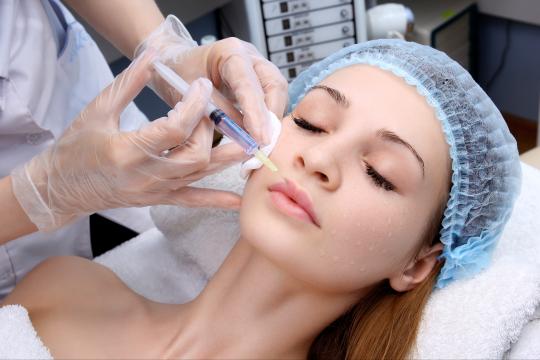
We’ve waxed on about the ‘liquid facelift’ and raved about the anti-aging ability of dermal fillers to replace lost volume in an earlobe, but the use of injectables in cosmetic plastic surgery doesn’t stop there. According to statistics from the American Society of Aesthetic Plastic Surgery (ASAPS) , injectable procedures have gone up a whopping 39% in the last 5 years alone, giving doctors the ability to cosmetically improve upon features that were once the strict territory of surgical procedures. Which brings us straight to today’s topic—the liquid nose job or nonsurgical rhinoplasty.
What is liquid rhinoplasty?
In the not-so-distant past, the only option to alter the shape of the nose was surgical rhinoplasty, but now plastic surgeons are using hyaluronic acid-based dermal fillers like Restylane and Juvederm to smooth a bumpy bridge, fill a depressed nasal side wall or ‘flip the tip’ on the nose, changing the shape in subtle ways without having to go under the knife. By carefully injecting the filler around an imperfection like a dorsal hump or a the curve of a crooked nose, your doctor can effectively camouflage the problem, making the nose appear perfectly straight. Strategically placed filler around the tip of a nose can offer a more refined and thinner appearance. And should a patient want a more lifted look to the tip of a nose, your doctor can carefully inject filler to the area or turn to that other “liquid” injectable, Botox to soften the muscle that pulls the nose down (depressor nasalis). Voila! A nonsurgical liquid nose job.
Pros and cons of liquid rhinoplasty.
A liquid nose job is best suited to patients seeking minor changes. It’s not typically used to address functional issues of the nose—like breathing problems. And, like other HA-based dermal fillers, the results of liquid rhinoplasty are temporary (lasting between 6-12 months). Using fillers that offer semi- or full-permanent results is not recommended and we’ll explain the terrifying risks below—but first let’s get all silver-lining on this issue of temporary results.
If you consider that you may not love the look of your newly flipped tip or slightly inflated nostril, you’ll have the option to either wait it out or have the filler dissolved with an injectable enzyme used to dissolve HA filler (called hyaluronaise). Some patients may even use this nonsurgical option to “test-drive” the look of a new nose, but be aware that most surgeons will recommend that you not opt for liquid rhinoplasty more than once or twice if you intend to ultimately opt for the more permanent surgical rhinoplasty—excess filler can sometimes make surgery more difficult.
So while liquid rhinoplasty isn’t the answer for everyone, for those patients who are good candidates, it can provide an immediate result with minimal downtime and side effects (slight bruising or swelling.) Your plastic surgeon can advise if liquid rhinoplasty is right for you.
Sounds easy, right? And it is. Until it isn’t. There are risks—and they’re a doozy. (You might want to sit down for these.)
Risks associate with liquid rhinoplasty.
All procedures—even the nonsurgical variety—come with risks and complications, and the risks associated with liquid rhinoplasty are no joke. It’s not the waiting out period of an overzealous Botox injection, or the necessity of a hyaluronidase injection to dissolve heavy-handed filler. Nope. We’re talking life-altering, cringe-worthy risks like skin death and blindness. Skin death and blindness. Let’s give that the moment of dramatic pause it deserves to ensure that it really sinks in.
The nose is extremely vascular and the chance that a less-experienced injector might misplace filler and cut off the blood flow in a critical artery or dam up the vital end arteries that feed your eyes retinas should scare the bejesus out of you. And we hope that all that terror you’re feeling will encourage you to only seek liquid rhinoplasty from a board-certified plastic surgeon with knowledge of the nose in all of its intricate glory, as well as experience in both surgical and nonsurgical rhinoplasty procedures. A board-certified plastic surgeon will also be aware of what complications to look for post-procedure and how best to address them to avoid any… you know…skin death and blindness.
From treating fine lines and less-fine folds to this and other “liquid” procedures, it’s clear that injectables and nonsurgical treatments are changing the plastic surgery landscape. Your plastic surgeon can help you decide if liquid rhinoplasty can offer a safe and successful result for you.








